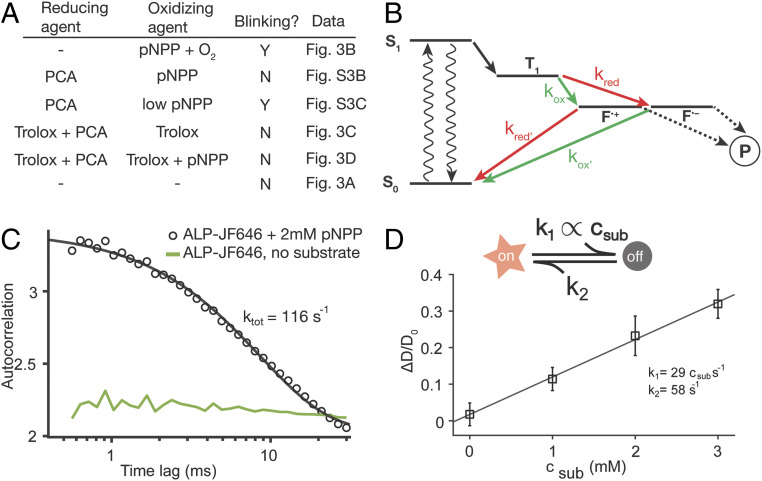Fig. 5.
pNPP-induced dye photophysics is responsible for the apparent diffusion enhancement of ALP in FCS. (A) Summary of all ABEL trap ALP-JF646 experiment buffer conditions with identified oxidizing and reducing agents and blinking outcome, showing consistency with the reducing and oxidizing framework as depicted in B. (B) A proposed model of pNPP-induced dye photophysics based on the reducing and oxidizing framework. The dye triple state (T1) can be oxidized (green arrows) or reduced (red arrows) into charge separated states (F•+ and F•−), which are not fluorescent and maybe prone to photobleaching (P). An oxidizing agent in solution needs to be balanced by the presence of a reducing agent (and vice versa) for blinking suppression, otherwise, the molecule is trapped in a dark radical state (F•+ or F•−) and blinks off. (C) Extracting pNPP-induced blinking kinetics from ABEL trap data. Intensity autocorrelation curve of ALP-JF646 with 2 mM pNPP (black circles, from the data represented by Fig. 3B) shows a pronounced decay between 1 ms and 30 ms and is fitted with a single exponential function (black line) to extract the total rate. The intensity autocorrelation of ALP-JF646 without substrate (from Fig. 3A) is shown in green for reference (amplitude multiplied by 10 for clarity). (D) Monte Carlo simulation of FCS experiments with a substrate-induced blinking model (Upper schematic, see text and SI Appendix for details), using the listed parameters constrained by the rate extracted in C. The extracted apparent diffusion coefficient (averaged over 10 independent simulation runs) is plotted against the substrate concentration and fit with a line. Error bars represent SD.

